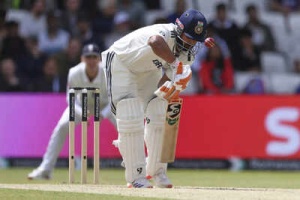Most people think leg pain is a natural sign of aging. It is easy to dismiss that agonizing cramping feeling on a walk if it goes away with rest. But experts warn that these are signs that something more ominous is going on in your arteries.
Dr. Sumit Kapadia, one of the finest vascular and endovascular specialists, recently shared a case of a patient who had blamed his leg pain on age. He described, "My legs hurt when I walked, but when I sat down, the pain went away. I figured it was not too bad." After they probed further, they discovered that the cause was blocked arteries in the legs, or Peripheral Artery Disease (PAD).
PAD affects blood flow to the lower body and, if not treated, can lead to severe problems like infections, ulcers, or amputation. Early detection is key, and in his patients, Dr. Kapadia regularly sees these six early warning signs:
This is one of the most classic early signs of PAD and is called claudication. It usually develops on walking a short distance and can feel like tightness, cramp, or ache in the calf, thigh, or buttocks. It goes away upon stopping walking, making most individuals ignore it. However, this pattern of pain is due to muscles not receiving enough blood when in use. Over time, this pain may even be felt when one is lying down, which also signifies the advancement of the disease.
Reduced blood circulation can cause legs to feel weak, tired, or cause a sensation of tingling. Others describe a heavy or "dead leg" sensation, especially when climbing stairs or for longer distances. Muscles and nerves depend upon oxygen from the blood to function normally. As blood flow is reduced, muscles fatigue quickly, and nerves are less able to send signals. The symptom may develop over time, making it easy to overlook until it starts affecting mobility in daily life.
Differences in leg temperature, especially one that is normally colder than the other, can be a sign of impaired circulation.This is because less oxygenated, warm blood is reaching the involved limb. It's usually most prominent from the knee on down. If you put your hands on both legs and one feels significantly colder even in hot weather, you need to report it to your doctor. Reduced blood flow can result in skin color changes over time and more profound damage to tissues.
If one has a sore, blister, or cut on your foot that heals over weeks, it may result from the poor circulation of PAD. Oxygen and nutrients that your skin needs to heal are provided by blood. The arteries become blocked, and wounds then heal slowly and tend to get infected. At times, these sores fail to heal and form ulcers, a condition that results in severe infection and even amputation. Individuals with diabetes are especially at risk for this.
One's skin on your legs and feet may begin to look different as circulation slows. They might notice it thinning out, looking shiny, or smooth. Hair can even stop growing where it used to have normal coverage. All this is happening because the skin and hair follicles are not properly nourished and oxygenated. The prolonged lack of sustenance debilitates the skin, making it vulnerable to injury in the long run. Even though it may be a cosmetic problem at first, it is often an early sign of underlying PAD.
The physicians can feel for a pulse in some areas along your ankles and feet. If one has no pulse or a weak pulse, it means that blood is not flowing through the arteries as it normally would. This is one of the simplest indications of clogged arteries. You may not notice it yourself, but it's a valuable part of an exam. If PAD is suspected, your physician can ask for tests such as an ankle-brachial index (ABI) to check blood flow through the legs.
Early detection of PAD is important, as it can prevent complications, notes Dr. Sumit Kapadia. If detected early, treatment might involve lifestyle modifications, medicines, or minor procedures that enhance blood flow. The more it's neglected, the higher the risk of permanent damage.
Newer articles
Older articles
 Wimbledon 2025: Dates, Prize Money, and How to Watch Live in US & India
Wimbledon 2025: Dates, Prize Money, and How to Watch Live in US & India
 Gujarat Cricket Association Set to Launch T20 Tournament in 2025-26 Season
Gujarat Cricket Association Set to Launch T20 Tournament in 2025-26 Season
 Praggnanandhaa Joins Carlsen's Team Liquid Ahead of Esports World Cup Showdown
Praggnanandhaa Joins Carlsen's Team Liquid Ahead of Esports World Cup Showdown
 Smith Poised for Grenada Test Return After Finger Injury Recovery
Smith Poised for Grenada Test Return After Finger Injury Recovery
 India vs. England 2025: Broad Warns England of Lethal Indian Pace Attack Ahead of Lord's Test
India vs. England 2025: Broad Warns England of Lethal Indian Pace Attack Ahead of Lord's Test
 Asia Cup 2025: ACC Eyes September Launch Amid Easing India-Pakistan Tensions
Asia Cup 2025: ACC Eyes September Launch Amid Easing India-Pakistan Tensions
 Raducanu Shuts Down Alcaraz Romance Rumors, Confirms US Open Doubles Partnership
Raducanu Shuts Down Alcaraz Romance Rumors, Confirms US Open Doubles Partnership
 Prithvi Shaw Acknowledges Career Setbacks, Cites Distractions and Poor Choices
Prithvi Shaw Acknowledges Career Setbacks, Cites Distractions and Poor Choices
 Mandhana Makes History: First Indian Woman to Score Centuries in All Cricket Formats
Mandhana Makes History: First Indian Woman to Score Centuries in All Cricket Formats
 Pant's Fearless Batting Sparks Gilchrist Comparisons: Chappell's Honest Assessment of India Star's Twin Tons Against England
Pant's Fearless Batting Sparks Gilchrist Comparisons: Chappell's Honest Assessment of India Star's Twin Tons Against England